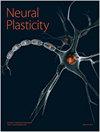Preferential Involvement of BRCA1/BARD1, Not Tip60/Fe65, in DNA Double-Strand Break Repair in Presenilin-1 P117L Alzheimer Models
IF 3.7
4区 医学
Q2 Medicine
引用次数: 3
Abstract
Recently, we showed that DNA double-strand breaks (DSBs) are increased by the Aβ42-amyloid peptide and decreased by all-trans retinoic acid (RA) in SH-SY5Y cells and C57BL/6J mice. The present work was aimed at investigating DSBs in cells and murine models of Alzheimer's disease carrying the preseniline-1 (PS1) P117L mutation. We observed that DSBs could hardly decrease following RA treatment in the mutated cells compared to the wild-type cells. The activation of the amyloidogenic pathway is proposed in the former case as Aβ42- and RA-dependent DSBs changes were reproduced by an α-secretase and a γ-secretase inhibitions, respectively. Unexpectedly, the PS1 P117L cells showed lower DSB levels than the controls. As the DSB repair proteins Tip60 and Fe65 were less expressed in the mutated cell nuclei, they do not appear to contribute to this difference. On the contrary, full-length BRCA1 and BARD1 proteins were significantly increased in the chromatin compartment of the mutated cells, suggesting that they decrease DSBs in the pathological situation. These Western blot data were corroborated by in situ proximity ligation assays: the numbers of BRCA1-BARD1, not of Fe65-Tip60 heterodimers, were increased only in the mutated cell nuclei. RA also enhanced the expression of BARD1 and of the 90 kDa BRCA1 isoform. The increased BRCA1 expression in the mutated cells can be related to the enhanced difficulty to inhibit this pathway by BRCA1 siRNA in these cells. Overall, our study suggests that at earlier stages of the disease, similarly to PS1 P117L cells, a compensatory mechanism exists that decreases DSB levels via an activation of the BRCA1/BARD1 pathway. This supports the importance of this pathway in neuroprotection against Alzheimer's disease.早老素-1 P117L阿尔茨海默病模型中DNA双链断裂修复优先参与BRCA1/BARD1,而非Tip60/Fe65
最近,我们发现在SH-SY5Y细胞和C57BL/6J小鼠中,a - β42淀粉样肽增加了DNA双链断裂(DSBs),全反式维甲酸(RA)减少了DNA双链断裂(DSBs)。目前的工作旨在研究携带早老素-1 (PS1) P117L突变的阿尔茨海默病细胞和小鼠模型中的DSBs。我们观察到,与野生型细胞相比,突变细胞的DSBs在RA治疗后几乎没有减少。在前一种情况下,α-分泌酶和γ-分泌酶分别抑制了a - β42和ra依赖性DSBs的变化,从而提出了淀粉样蛋白生成途径的激活。出乎意料的是,PS1 P117L细胞的DSB水平低于对照组。由于DSB修复蛋白Tip60和Fe65在突变细胞核中的表达较少,因此它们似乎不会导致这种差异。相反,突变细胞的全长BRCA1和BARD1蛋白在染色质室中显著增加,表明它们在病理情况下降低了dsb。这些Western blot数据被原位接近结扎实验证实:BRCA1-BARD1的数量增加,而非Fe65-Tip60异源二聚体的数量,仅在突变细胞核中增加。RA还增强了BARD1和90 kDa BRCA1亚型的表达。突变细胞中BRCA1表达的增加可能与这些细胞中BRCA1 siRNA抑制该途径的难度增加有关。总的来说,我们的研究表明,在疾病的早期阶段,与PS1 P117L细胞类似,存在一种通过激活BRCA1/BARD1途径降低DSB水平的代偿机制。这支持了该通路在抗阿尔茨海默病的神经保护中的重要性。
本文章由计算机程序翻译,如有差异,请以英文原文为准。
求助全文
约1分钟内获得全文
求助全文
来源期刊

Neural Plasticity
Neuroscience-Neurology
CiteScore
5.70
自引率
0.00%
发文量
0
审稿时长
1 months
期刊介绍:
Neural Plasticity is an international, interdisciplinary journal dedicated to the publication of articles related to all aspects of neural plasticity, with special emphasis on its functional significance as reflected in behavior and in psychopathology. Neural Plasticity publishes research and review articles from the entire range of relevant disciplines, including basic neuroscience, behavioral neuroscience, cognitive neuroscience, biological psychology, and biological psychiatry.
 求助内容:
求助内容: 应助结果提醒方式:
应助结果提醒方式:


